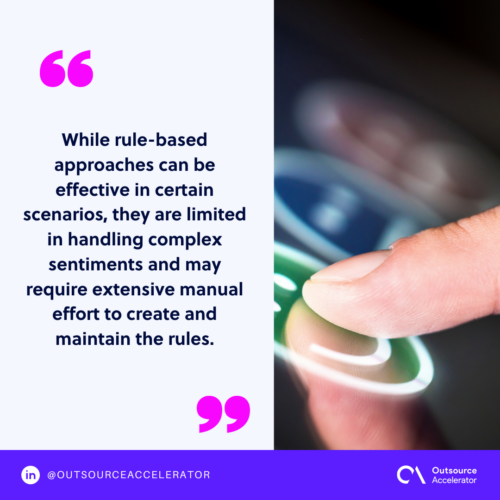Classifying data’s emotional tone via sentiment analysis

Customer feedback is critical to every enterprise. It determines whether they give their consumers satisfactory service or need to improve their offerings.
Organizations can classify and extract emotional tones from textual data through sentiment analysis. Understanding the emotions expressed within customer reviews can provide valuable insights to drive decision-making processes.
Defining sentiment analysis
Sentiment analysis, also known as opinion mining, refers to the process of determining the emotional tone behind a piece of text. This procedure aims to classify the sentiment behind customer reviews as positive, negative, or neutral.
By applying natural language processing (NLP) techniques and machine learning algorithms, sentiment analysis enables automated interpretation of subjective information.

Fundamentals of sentiment analysis
Two fundamental steps must be followed to perform sentiment analysis effectively:
Text preprocessing
Text preprocessing involves cleaning and preparing the raw text data to ensure accurate sentiment analysis results.
This step typically includes removing punctuation, converting text to lowercase, handling special characters, and eliminating stop words (common words that do not carry significant sentiment).
Feature extraction
Feature extraction converts textual data into numerical features that machine learning algorithms can use to create codes.
Some of the common feature extraction techniques used in sentiment analysis include:
- Term frequency and inverse document frequency (TF-IDF)
- Word embeddings (e.g., Word2Vec and GloVe)
Application of classification models
Once the features are extracted, classification models are employed to classify the sentiment of the text.
Three popular machine learning algorithms have proven effective in sentiment analysis.
Support vector machines (SVM)
SVMs utilize a hyperplane to separate data into different classes based on their features.
For instance, given a set of movie reviews, an SVM can analyze the features of each review (e.g., the occurrence of certain words or phrases) and classify them as positive, negative, or neutral.
SVM has shown good performance in sentiment analysis tasks due to its ability to handle high-dimensional data effectively.
Hidden markov models (HMM)
HMMs are widely used in sequential and diagnostic analytics. In this models, the context of the text matter. HMM can capture the dependencies between words and conclude the emotional tone accordingly.
In analyzing a conversation, for instance, an HMM can consider the sentiment of previous words or phrases to predict the sentiment of the current word or phrase.
This contextual analysis allows for a more nuanced understanding of sentiment in natural language.
Naive bayes classifier (NBC)
An NBC is a probabilistic model that assumes independence between features. When classifying customer reviews as positive or negative, it can calculate the probabilities of each sentiment label based on the repeating words in the review.
Despite its simplicity, it has proven effective in sentiment analysis tasks, especially with large datasets.
Sentiment analysis: Techniques and approaches
Sentiment analysis techniques can be broadly categorized into rule-based, lexicon-based, and machine-learning approaches.
Rule-based approaches
Rule-based approaches in sentiment analysis involve defining a set of handcrafted rules or heuristics to identify sentiment based on predefined patterns or linguistic cues.
These approaches often rely on sentiment-specific keywords, grammatical rules, and syntactic structures to determine sentiment polarity.
While rule-based approaches can be effective in certain scenarios, they are limited in handling complex sentiments and may require extensive manual effort to create and maintain the rules.

Lexicon-based approaches
Lexicon-based approaches utilize sentiment lexicons. These lexicons assign a sentiment score to each word or phrase in the customer review, indicating its positive, negative, or neutral tone.
By numbering the sentiment scores of individual words in a text, lexicon-based approaches estimate the overall sentiment.
This sentiment analysis approach is valuable when it needs to be performed quickly and in real-time, but it can struggle with detecting slang words not present in the lexicon.
Machine learning approaches
Machine learning approaches in sentiment analysis involve training models on labeled datasets to learn patterns and make predictions on new, unlabeled data. These approaches utilize algorithms such as SVM, HMM, Naive Bayes, or deep learning models.
With proper training, machine learning approaches can handle complex relationships, generalize unseen and raw data, and adapt to different domains.
Role of sentiment analysis in customer experience
Sentiment analysis enhances the customer experience by providing insights into customer feedbacks, identifying pain points, and managing brand reputation.
Here are the following roles of sentiment analysis:
Performing feedback analysis
Businesses can deeply understand customers’ opinions regarding their products or services by analyzing customer feedback via sentiment analysis.
This analysis helps companies identify areas of improvement, address customer concerns, and make data-driven decisions to enhance the customer experience.
Identifying customer pain points
Sentiment analysis helps identify customer pain points by uncovering unfavorable reviews or dissatisfaction expressed in the platform’s feedback box or social media posts.
Businesses can proactively address the issues and provide better customer support by pinpointing these pain points.

Brand reputation management
Monitoring sentiment analysis of social media mentions, online reviews, and news articles allows businesses to track their brand reputation in real-time.
By promptly identifying negative sentiments, companies can effectively manage their brand reputation, enhance their offerings, and maintain a positive brand image.
Examine the tone of customer reviews via sentiment analysis
One of the key applications of sentiment analysis is examining the tone of customer reviews. By analyzing the sentiment expressed in customer reviews, you can:
- Measure customer satisfaction
- Identify areas for improvement
- Make data-driven decisions
Overall, sentiment analysis enables your business to categorize reviews (as positive, negative, or neutral) and lets you create a solution that best addresses each of your customer’s concerns.







 Independent
Independent




